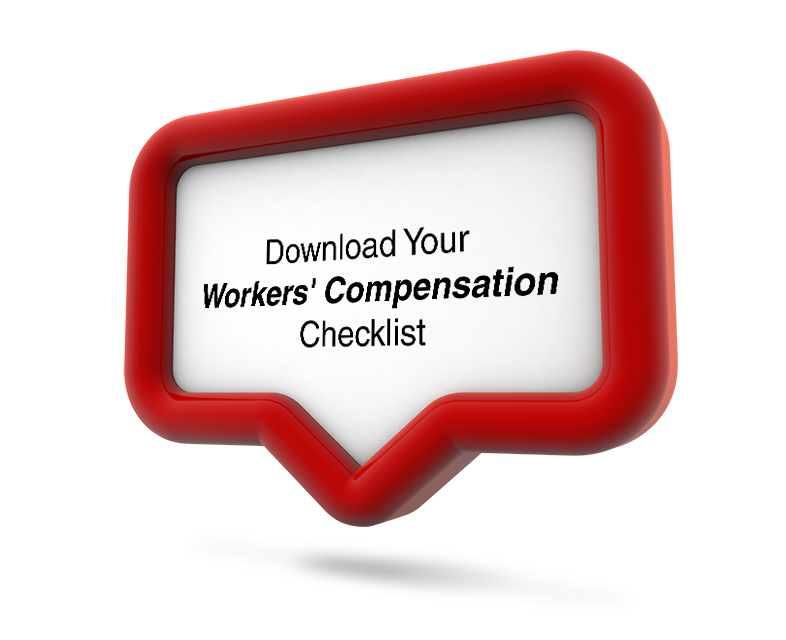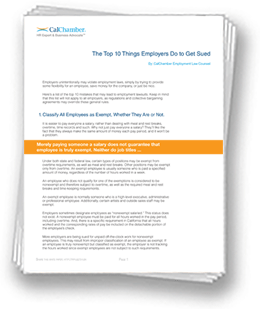California Workers' Compensation
What is workers' compensation (workers' comp)? Workers' compensation insurance is a no-fault insurance system. The workers' compensation program is a trade-off that exchanges your limited absolute liability for work-related injuries and illnesses for your employees' common law right to sue you for damages. If your employee is injured on the job, your workers' compensation insurance will provide such benefits as temporary disability, medical expenses and permanent disability award, if appropriate, based on the injury’s long-term effects.


Common Mistake
- Not carrying workers' compensation insurance or allowing it to lapse.
Acquire Workers' Compensation Insurance Coverage for Your Needs
Carrying workers' compensation insurance is a basic requirement of being an employer in California. You must have workers' compensation coverage while your business is in operation. If you fail to provide coverage and an injury occurs, not only will you have to pay the employee's medical costs, but you’ll also risk additional liability in the form of penalties and the possibility of lawsuits.
Post All Legally Required Forms, Posters and Notices
All current employees must easily see the California Workers' Compensation poster that contains information about your insurance representative, medical emergency telephone numbers and the claims administration contact information. All new employees must be handed the California Workers' Compensation pamphlet. This notice describes employers’ and employees’ rights and obligations and includes forms for pre-designating a health care provider as well as a personal chiropractor and a personal acupuncturist. There are other claim and reporting forms. Visit our online store to purchase Workers' Compensation Pamphlets and Required Posters and Notices.
Know How Workers' Compensation in California Works
There is a difference between first aid and medical care. You have minimal reporting obligations if the injured worker loses no time from work beyond the date of the injury and the treatment falls within the definition of first aid. Classification of cases as first aid saves you money because they do not affect your insurance premiums. For serious injuries, send the employee for medical care and call their emergency contact immediately.
In most cases, you may designate the treating physician for at least the first 30 days following an injury. If your insurer has selected one or more Medical Provider Networks to treat your employees' work-related injuries, you must provide additional information to your employees.
You must provide the information below in a timely manner:
- Report of a death or serious injury requiring hospitalization (not including medical observation or diagnostic testing), or in which an employee suffers an amputation, the loss of an eye, or any serious degree of permanent disfigurement to Cal/OSHA within eight hours; and
- Workers' compensation claim forms within one working day of receiving notice of the employee’s injury.
There are reporting and recordkeeping obligations for all injuries. Be sure your supervisors are aware of your company's obligations under California's workers' compensation laws to care for injured workers, provide claim forms and document injuries.
Stay in Touch With Your Employee
This seems obvious, but it is a critical step in controlling the cost of your workers' compensation claims. Employees who feel they understand the process, and feel valued as a member of your workforce, are more likely to keep their medical appointments, follow medical instructions, cooperate with the claims adjuster and have a desire to return to either their regular job or a slightly modified one, customized to their needs. Call the doctor and stay informed of the employee's status.
Review the Doctor's First Report and Investigate the Accident
No company wants a repeat incident, so investigate the accident and determine the exact cause of injury. Interview any coworkers or witnesses and inspect the workplace environment to identify corrective actions that will prevent recurrence. Use these notes in your Log 300 records to satisfy obligations under your Injury and Illness Prevention Program. Focus on new opportunities for the employee to return to work and discuss work limitations and potential accommodations with the doctor. The most efficient way to control workers' compensation costs is to get people back to work with a modified duty program.
Related Resources
CalChamber members have access to several tools and services that help those who manage human resources to work through workers' compensation issues, including:
Workers' Compensation Claim Form - DWC 1
If an employee suffers a work-related injury or illness, the employee may be entitled to workers' compensation benefits. Give this form to the employee and have the employee complete the "Employee" section and then return the form to you.
Workers' Compensation Benefits for Victims of Workplace Violence
Use this sample notice when an employee is a victim of a crime at your workplace. You must give the employee written notification of their eligibility for workers' compensation benefits for resulting injuries, including psychiatric injuries.
Workers' Compensation Checklist
Complete this checklist to fulfill your obligations regarding workers' compensation.


